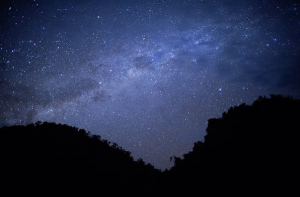Light pollution and the decline of starry nights
Opinion: Bright Nights, Big Problems – recent opinion piece in National Geographic on the growing rarity of true darkness, due primarily to our unthinking use of artificial light.
Because of the rapid growth of light pollution over recent decades, most Americans under 40 have never known real darkness. …
… the steady loss of darkness from our lives is not easily quantified, for like the similarly endangered qualities of solitude and quiet, the true value of darkness is often intangible.
Take a brilliantly starry sky. Since the beginning of time, a sky plush with stars was part of the common human experience. Everywhere on Earth, on most nights, our ancestors came face to face with the universe. This experience influenced their religious beliefs, mythologies, art—their very understanding of their place in creation. Today, because of light pollution, two-thirds of those in the United States and western Europe live where they cannot see the Milky Way, and 99 percent of us live under skies polluted by light.
For the tens of millions who live under a night sky showing 25 stars or fewer, it is nearly impossible to imagine a natural sky of some 2,500 individual stars backed by great swathes of uncountable billions. Our night sky continues to shape us, but now it is the absence of the universe around us that influences our religious beliefs, our myths, our impulse to create. We are being shaped by a diminished experience of darkness, and most of us don’t even know what we are missing.
The piece above is by Paul Bogard, author of the recently released book The End of the Night: Searching for Natural Darkness in an Age of Artificial Light.
In an interview, Is Light Pollution the Easiest Environmental Problem to Fix?, he’s clear that he’s not advocating an end to our use of artificial light, but would like us to use it carefully, especially considering what we’re learning about the far-reaching negative health effects of lack of darkness and the energy used to maintain ever-increasing light levels at night.
We’re not going do away with light because light at night is amazing. It’s a miracle, and people wouldn’t stand for not having light anyway. But there are so many things we could do to control it and contain it and to use it intelligently, …
The International Dark-Sky Association is a great place to learn more about what we can do to reduce unnecessary light at night; their newsletter has most of the links in this post, as well as links to video clips and other articles.
Even if you can’t see a single star when you look up at night, check out NASA’s Astronomy Picture of the Day (APOD) for endlessly fascinating images of our universe, and also the UNESCO / IAU’s The World At Night (TWAN).
Image credit: Photograph by Stephen Alvarez, National Geographic


